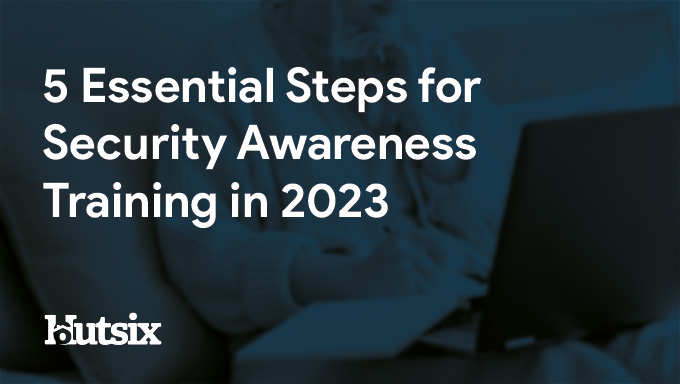New AI and Chatbot Tutorial
Hut Six is delighted to announce the release of our highly anticipated tutorial focusing on the intersection of Artificial Intelligence (AI) and information security. This comprehensive tutorial is now available to help you stay ahead in the rapidly evolving landscape of cybersecurity.
Looking to train your employees on AI security?
Talk to one of our experts about effective training now.
AI in Cyber & Information Security
With the increasing prevalence of AI technologies, it is crucial to understand the dual role AI plays in both enhancing and challenging information security. Our new tutorial provides an insightful exploration of the relationship between AI and cybersecurity, equipping your team with the foundational knowledge needed to navigate this dynamic field effectively.
We discuss how AI influences security practices, from improving threat detection to identifying vulnerabilities, and how security measures shape the development and deployment of AI systems. By the end of this tutorial, users will have a solid understanding of how to ensure AI can be securely integrated into your organisation's security framework.
Read more: A Guide to AI Security Policy
Common Chatbot Use Cases
AI, particularly chatbots, has numerous practical applications in several key areas:
- Customer Support: AI systems like ChatGPT provide instant, efficient responses to customer inquiries, enhancing user experience and streamlining communication processes.
- Content Generation: Chatbots can generate large quantities of text, including articles, marketing copy, and creative writing, saving time and resources.
- Language Translation: Real-time language translation facilitated by chatbots breaks down communication barriers and fosters global collaboration.
- Personal Assistance: Chatbots act as virtual assistants, helping users with scheduling, reminders, and general information.
- Educational Support: AI is implemented in educational settings to offer tutoring, answer student questions, and support learning materials.
These use cases also come with potential security implications. Understanding best practices for safe implementation is essential to leverage these technologies effectively.
Read more: AI and the Future of Spear Phishing
Essential Information Security Topics
Our tutorial also addresses critical information security concerns related to AI, focusing on two primary areas:
Unreliable Output
AI systems, while powerful, can produce outputs that are false, misleading, or sub-optimal. This phenomenon, known as 'AI hallucinations,' arises because these systems are trained on vast amounts of data from the internet, which can include inaccuracies.
Examples:
- False Medical Advice: An AI chatbot providing incorrect medical advice based on outdated or incorrect information, potentially leading to harmful consequences for users.
- Misleading Financial Information: AI-generated financial reports or investment advice that contain errors, causing poor decision-making and financial losses.
- Biased Hiring Recommendations: An AI recruitment tool favouring certain candidates due to biased training data, resulting in unfair hiring practices and lack of diversity.
Our tutorial highlights the importance of verifying AI-generated content and understanding the limitations and potential pitfalls of relying on AI outputs.
Privacy & Data Security
AI systems often process user inputs to improve their models, which raises significant privacy and data security concerns.
Examples:
- Confidential Data Leakage: Sensitive company information entered into a chatbot for troubleshooting gets stored and inadvertently accessed by unauthorised parties.
- Personal Data Misuse: User data collected by AI systems being used for purposes beyond the original intent, violating privacy agreements and regulations.
- Phishing Attacks: AI-generated phishing emails crafted using personal information obtained from insecure AI interactions, making them highly convincing and dangerous.
Our tutorial emphasises the need for strict data handling policies, ensuring that employees treat chatbots as non-trusted entities and avoid sharing sensitive information.
Effective & Ongoing Awareness Training
At Hut Six, we are committed to continuously enhancing our content library to address the evolving threats in information security. Our training programmes are designed to be engaging and deliver tangible value, fostering a security-aware culture within your organisation.
This new tutorial is part of our ongoing efforts to provide relevant, up-to-date training that empowers your employees to recognise, avoid, and report cyber threats effectively. By focusing on AI and its implications for security, we aim to reduce human error and promote positive behavioural changes that strengthen your organisation's defences.
Join us in exploring the future of information security with our latest tutorial, and ensure your team is equipped to handle the challenges and opportunities presented by AI.
Security Awareness for your Organisation
Enjoyed our blog? Learn more about how Hut Six can help improve you security awareness with training and simulated phishing. Start a free trial now, or book a meeting with one of our experts.
Featured
What is the Impact of Security Awareness Training? - Hut Six
Discover the Impact of Security Awareness Training: Prevent breaches, foster culture, & build trust.
What is Personal Data?
Learn about personal data, its types, and significance in data protection. Explore general and special category data, as well as pseudonymised and anonymised data under the GDPR.
Who Does GDPR Apply To?
Who Does GDPR Apply To? And Other Data Protection Questions/ Information Security blog by Information security awareness provider Hut Six Security.
Does ChatGPT Pose a Cybersecurity Risk
In this blog post, we explore whether AI chatbots like ChatGPT pose a cybersecurity risk. We delve into the potential vulnerabilities and threats posed by chatbots, and discuss measures that can be taken to mitigate these risks. Read on to discover how you can ensure the security of your organisation's chatbot interactions.
How Do I Get Cyber Essentials Certified?
Learn how to obtain Cyber Essentials certification and enhance your organization's cybersecurity posture with our comprehensive guide. Our expert insights will help you navigate the certification process to meet the requirements for Cyber Essentials.
Essential Steps for Security Awareness Training
Starting a security awareness training campaign? Here are 5 essential steps to help ensure information security success.
Malicious Insider Threats - Meaning & Examples
Malicious insider threats can cause massive problems. Here we examine some of the motivations behind attacks and methods of detection organisations can use to reduce risk.
5 Biggest Breaches of 2022 (So Far)
Five of the biggest and most significant data breaches, hacks, and information security attacks of 2022 (so far).
Auditing for GDPR Compliance
Questions to consider when auditing your business or SME for General Data Protection Regulation (GDPR) compliance.
Improving Employee Cyber Security
With human error responsible for many breaches and attacks, we offer some helpful areas for improving employee security compliance.












